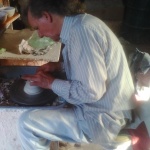This is the best way. Attention to detail, and reflection, at every stage, for the best possible pots.
1. The Clay
My pots feature two porcelain clays, one for the cooler part of the kiln and the other for the hotter part. PORCELAIN is the purest and whitest of the high temperature clays. It is both the most sensuous to work with on the wheel because of its silky smoothness, and the most demanding: every action needs to be just so or it will flop.
Fired to near its vitrification point, it is the strongest of the clays and promotes also the brightest and deepest glaze colour. In the case of high temperature WOOD FIRING, ash and flame markings may be at once dramatic, and subtle. I have developed my own porcelain clay body, and this , with the excellent Southern Ice porcelain, have been the basis for the most recent work.
2. Making the pots
Pots have been hand thrown on a potters wheel, to as near the finished shape as possible. When half dry, pots were returned to the wheel for “turning” the final shape. That is, shaving back the surface with a sharp tool to more precisely define the shape wanted. Each piece was judged by eye and is a unique combination of curves that converge and diverge, of light and shadow.
3. Drying
Pots have been glazed at the optimum stage of dryness to ensure the best possible glaze fit. The glaze and the clay then shrink evenly together, in a process known as “raw glazing”.
In a time consuming process, the MARBLED pots were carefully turned again to bring out their inherent patterns that would otherwise be clouded.

4. Glazing
Pots have been glazed on the inside (with the exception of pestles and mortars). The firing process glazes them naturally on the outside, from the flame and the fine melting ash. Clay slips have often been applied to the exterior to enhance this natural glazing.
All NON TOXIC materials are the highest priority. Colours, and quality, have been carefully tested in previous firings. Endless test tiles have enabled the development of highly individual glazes and clay surfaces.
5. Packing the kiln
The kiln is packed carefully over two to three days to maximize the available space, to plan around likely flame paths and to allow for temperature and atmosphere variations. The firing itself involves a pre-heat the day before of about 9 hours with a small fire. The following day is up to 19 hours of constant attention.

6. The wood
Different woods, because of chemical composition, have a significant effect on the colours and the ashing textures of the surface of the pots. In this case the sensuous licks and halos of green, violet, apricot, gold are from LOCAL trees.
Wood was cut to fit the exact width of the firebox. It has to be split, stacked and sorted and as dry as possible before the firing starts.

7. The Firing
I start before dawn on the firing day. It is hard physical work throughout and the continuous anticipation of what effect actions will have ten minutes ahead.
It becomes a type of meditation. I fire alone and become totally involved in the process. There is much to attend to at every stage of the firing. Sudden rises or plummets in temperature can occur if attention wavers. Patience, calmness, energy and clear thinking are essential. At the end, there is about a two-hour soak to peak at top temperature (1300oC), where the clay and glazes will mature evenly and the ashing and flame effects are maximized. This is a serene and special time, just the soft rumble of the kiln and the stars above.
Choosing the exact moment to close down is incredibly hard to judge. It is a matter of experience and intuition.
After a day and a half, the kiln has cooled sufficiently to have that first look. I have never ceased to be delighted and relieved to have gone fairly close to “just right”.

8. Sanding and finishing
Where the pot has rested in the kiln the base is likely to still be a bit rough. To ensure it is comfortable to hold and safe for all surfaces the base was finely sanded and cleaned of any residue. All pots have been checked carefully for any minor cracks or other defects at this stage as well.
9. I have a “casual” stall at Salamanca Market. Love to be there but not always possible. E-mail me on the Friday to get stall location, as it changes.

